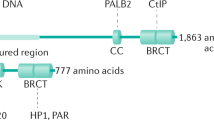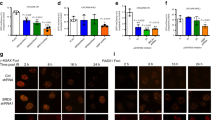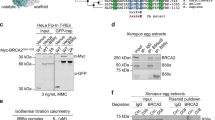Abstract
BRCA1 and the DNA helicase FANCJ (also known as BACH1 or BRIP1) have common functions in breast cancer suppression and DNA repair. However, the functional significance of the direct interaction between BRCA1 and FANCJ remains unclear. Here, we have discovered that BRCA1 binding to FANCJ regulates DNA damage repair choice. Thus, when FANCJ binding to BRCA1 is ablated, the molecular mechanism chosen for the repair of damaged DNA is dramatically altered. Specifically, a FANCJ protein that cannot be phosphorylated at serine 990 or bind BRCA1 inhibits DNA repair via homologous recombination and promotes polη-dependent bypass. Furthermore, the polη-dependent bypass promoted by FANCJ requires the direct binding to the mismatch repair (MMR) protein, MLH1. Together, our findings implicate that in human cells BRCA1 binding to FANCJ is critical to regulate DNA repair choice and promote genomic stability. Moreover, unregulated FANCJ function could be associated with cancer and/or chemoresistance.
This is a preview of subscription content, access via your institution
Access options
Subscribe to this journal
Receive 50 print issues and online access
$259.00 per year
only $5.18 per issue
Buy this article
- Purchase on Springer Link
- Instant access to full article PDF
Prices may be subject to local taxes which are calculated during checkout





Similar content being viewed by others
References
Albertella MR, Green CM, Lehmann AR, O'Connor MJ . (2005). A role for polymerase eta in the cellular tolerance to cisplatin-induced damage. Cancer Res 65: 9799–9806.
Alt A, Lammens K, Chiocchini C, Lammens A, Pieck JC, Kuch D et al. (2007). Bypass of DNA lesions generated during anticancer treatment with cisplatin by DNA polymerase eta. Science 318: 967–970.
Barbour L, Xiao W . (2003). Regulation of alternative replication bypass pathways at stalled replication forks and its effects on genome stability: a yeast model. Mutat Res 532: 137–155.
Barber LJ, Youds JL, Ward JD, McIlwraith MJ, O'Neil NJ, Petalcorin MI et al. (2008). RTEL1 maintains genomic stability by suppressing homologous recombination. Cell 135: 261–271.
Bhattacharyya A, Ear US, Koller BH, Weichselbaum RR, Bishop DK . (2000). The breast cancer susceptibility gene BRCA1 is required for subnuclear assembly of Rad51 and survival following treatment with the DNA cross-linking agent cisplatin. J Biol Chem 275: 23899–23903.
Bridge WL, Vandenberg CJ, Franklin RJ, Hiom K . (2005). The BRIP1 helicase functions independently of BRCA1 in the Fanconi anemia pathway for DNA crosslink repair. Nat Genet 37: 953–957.
Bugreev DV, Yu X, Egelman EH, Mazin AV . (2007). Novel pro- and anti-recombination activities of the Bloom's syndrome helicase. Genes Dev 21: 3085–3094.
Cantor S, Drapkin R, Zhang F, Lin Y, Han J, Pamidi S et al. (2004). The BRCA1-associated protein BACH1 is a DNA helicase targeted by clinically relevant inactivating mutations. Proc Natl Acad Sci USA 101: 2357–2362.
Cantor SB, Andreassen PR . (2006). Assessing the link between BACH1 and BRCA1 in the FA pathway. Cell Cycle 5: 164–167.
Cantor SB, Bell DW, Ganesan S, Kass EM, Drapkin R, Grossman S et al. (2001). BACH1, a novel helicase-like protein, interacts directly with BRCA1 and contributes to its DNA repair function. Cell 105: 149–160.
Delacote F, Deriano L, Lambert S, Bertrand P, Saintigny Y, Lopez BS . (2007). Chronic exposure to sublethal doses of radiation mimetic Zeocin selects for clones deficient in homologous recombination. Mutat Res 615: 125–133.
Dronkert ML, Kanaar R . (2001). Repair of DNA interstrand cross-links. Mutat Res 486: 217–247.
Dupaigne P, Le Breton C, Fabre F, Gangloff S, Le Cam E, Veaute X . (2008). The Srs2 helicase activity is stimulated by Rad51 filaments on dsDNA: implications for crossover incidence during mitotic recombination. Mol Cell 29: 243–254.
Eelen G, Vanden Bempt I, Verlinden L, Drijkoningen M, Smeets A, Neven P et al. (2008). Expression of the BRCA1-interacting protein Brip1/BACH1/FANCJ is driven by E2F and correlates with human breast cancer malignancy. Oncogene 27: 4233–4241.
Gupta R, Sharma S, Sommers JA, Jin Z, Cantor SB, Brosh Jr RM . (2005). Analysis of the DNA substrate specificity of the human BACH1 helicase associated with breast cancer. J Biol Chem 280: 25450–25460.
Hinz JM, Nham PB, Salazar EP, Thompson LH . (2006). The Fanconi anemia pathway limits the severity of mutagenesis. DNA Repair (Amst) 5: 875–884.
Kannouche P, Broughton BC, Volker M, Hanaoka F, Mullenders LH, Lehmann AR . (2001). Domain structure, localization, and function of DNA polymerase eta, defective in xeroderma pigmentosum variant cells. Genes Dev 15: 158–172.
Kannouche PL, Lehmann AR . (2004). Ubiquitination of PCNA and the polymerase switch in human cells. Cell Cycle 3: 1011–1013.
Kawamoto T, Araki K, Sonoda E, Yamashita YM, Harada K, Kikuchi K et al. (2005). Dual roles for DNA polymerase eta in homologous DNA recombination and translesion DNA synthesis. Mol Cell 20: 793–799.
Kim H, Chen J . (2008). New players in the BRCA1-mediated DNA damage responsive pathway. Mol Cells 25: 457–461.
Levitus M, Waisfisz Q, Godthelp BC, Vries YD, Hussain S, Wiegant WW et al. (2005). The DNA helicase BRIP1 is defective in Fanconi anemia complementation group J. Nat Genet 37: 934–935.
Levran O, Attwooll C, Henry RT, Milton KL, Neveling K, Rio P et al. (2005). The BRCA1-interacting helicase BRIP1 is deficient in Fanconi anemia. Nat Genet 37: 931–933.
Litman R, Peng M, Jin Z, Zhang F, Zhang J, Powell S et al. (2005). BACH1 is critical for homologous recombination and appears to be the Fanconi anemia gene product FANCJ. Cancer Cell 8: 255–265.
McIlwraith MJ, Vaisman A, Liu Y, Fanning E, Woodgate R, West SC . (2005). Human DNA polymerase eta promotes DNA synthesis from strand invasion intermediates of homologous recombination. Mol Cell 20: 783–792.
Mechanic LE, Frankel BA, Matson SW . (2000). Escherichia coli MutL loads DNA helicase II onto DNA. J Biol Chem 275: 38337–38346.
Moynahan ME, Chiu JW, Koller BH, Jasin M . (1999). Brca1 controls homology-directed DNA repair. Mol Cell 4: 511–518.
Moynahan ME, Pierce AJ, Jasin M . (2001). BRCA2 is required for homology-directed repair of chromosomal breaks. Mol Cell 7: 263–272.
Niedernhofer LJ, Lalai AS, Hoeijmakers JH . (2005). Fanconi anemia (cross)linked to DNA repair. Cell 123: 1191–1198.
Niedzwiedz W, Mosedale G, Johnson M, Ong CY, Pace P, Patel KJ . (2004). The Fanconi anaemia gene FANCC promotes homologous recombination and error-prone DNA repair. Mol Cell 15: 607–620.
Nojima K, Hochegger H, Saberi A, Fukushima T, Kikuchi K, Yoshimura M et al. (2005). Multiple repair pathways mediate tolerance to chemotherapeutic cross-linking agents in vertebrate cells. Cancer Res 65: 11704–11711.
Papouli E, Chen S, Davies AA, Huttner D, Krejci L, Sung P et al. (2005). Crosstalk between SUMO and ubiquitin on PCNA is mediated by recruitment of the helicase Srs2p. Mol Cell 19: 123–133.
Patel KJ, Joenje H . (2007). Fanconi anemia and DNA replication repair. DNA Repair (Amst) 6: 885–890.
Peng M, Litman R, Xie J, Sharma S, Brosh Jr RM, Cantor SB . (2007). The FANCJ/MutLalpha interaction is required for correction of the cross-link response in FA-J cells. EMBO J 26: 3238–3249.
Pierce AJ, Johnson RD, Thompson LH, Jasin M . (1999). XRCC3 promotes homology-directed repair of DNA damage in mammalian cells. Genes Dev 13: 2633–2638.
Prakash S, Johnson RE, Prakash L . (2005). Eukaryotic translesion synthesis DNA polymerases: specificity of structure and function. Annu Rev Biochem 74: 317–353.
Seal S, Thompson D, Renwick A, Elliott A, Kelly P, Barfoot R et al. (2006). Truncating mutations in the Fanconi anemia J gene BRIP1 are low-penetrance breast cancer susceptibility alleles. Nat Genet 38: 1239–1241.
Shen X, Do H, Li Y, Chung WH, Tomasz M, de Winter JP et al. (2009). Recruitment of fanconi anemia and breast cancer proteins to DNA damage sites is differentially governed by replication. Mol Cell 35: 716–723.
Sinclair CS, Rowley M, Naderi A, Couch FJ . (2003). The 17q23 amplicon and breast cancer. Breast Cancer Res Treat 78: 313–322.
Sommers JA, Rawtani N, Gupta R, Bugreev DV, Mazin AV, Cantor SB et al. (2009). FANCJ uses its motor ATPase to disrupt protein-DNA complexes, unwind triplexes, and inhibit rad51 strand exchange. J Biol Chem 284: 7505–7517.
Wang W . (2007). Emergence of a DNA-damage response network consisting of Fanconi anaemia and BRCA proteins. Nat Rev Genet 8: 735–748.
Watanabe K, Tateishi S, Kawasuji M, Tsurimoto T, Inoue H, Yamaizumi M . (2004). Rad18 guides poleta to replication stalling sites through physical interaction and PCNA monoubiquitination. EMBO J 23: 3886–3896.
Yu X, Chini CC, He M, Mer G, Chen J . (2003). The BRCT domain is a phospho-protein binding domain. Science 302: 639–642.
Zheng H, Wang X, Warren AJ, Legerski RJ, Nairn RS, Hamilton JW et al. (2003). Nucleotide excision repair- and polymerase eta-mediated error-prone removal of mitomycin C interstrand cross-links. Mol Cell Biol 23: 754–761.
Acknowledgements
We thank Larry Thompson, Alan Lehmann, and Roger Greenberg for critical comments. We also thank Maria Jasin for the DR-U2OS cells and Alan Lehmann for the XPV-vector and polη-complemented lines as well as polη-GFP construct, Hans Joenje for FA-J cells, and Claire Baldwin for readership comments. This study was supported by NIH R01 CA129514-01A1 and from charitable contributions from Mr and Mrs Edward T Vitone Jr.
Author information
Authors and Affiliations
Corresponding author
Ethics declarations
Competing interests
The authors declare no conflict of interest.
Additional information
Supplementary Information accompanies the paper on the Oncogene website
Supplementary information
Rights and permissions
About this article
Cite this article
Xie, J., Litman, R., Wang, S. et al. Targeting the FANCJ–BRCA1 interaction promotes a switch from recombination to polη-dependent bypass. Oncogene 29, 2499–2508 (2010). https://doi.org/10.1038/onc.2010.18
Received:
Revised:
Accepted:
Published:
Issue Date:
DOI: https://doi.org/10.1038/onc.2010.18
Keywords
This article is cited by
-
Regulation of PERK expression by FOXO3: a vulnerability of drug-resistant cancer cells
Oncogene (2019)
-
The Fanconi anaemia pathway: new players and new functions
Nature Reviews Molecular Cell Biology (2016)
-
A variant at a potentially functional microRNA-binding site in BRIP1 was associated with risk of squamous cell carcinoma of the head and neck
Tumor Biology (2016)
-
The Forkhead Box M1 protein regulates BRIP1 expression and DNA damage repair in epirubicin treatment
Oncogene (2013)
-
Decreased FANCJ caused by 5FU contributes to the increased sensitivity to oxaliplatin in gastric cancer cells
Gastric Cancer (2013)



